Preface
List of Companies and Universities
Companies
Universities
Contents
About the Editors
Contributors
Part I: Fundamentals of Driver Assistance Development
1 Capabilities of Humans for Vehicle Guidance
1 Human Information Processing
1.1 Information Intake
1.2 Information Processing
1.3 Information Output
2 Driver Characteristics and the Limits of Human Performance Capacity
3 Demands on Vehicle Operators in the Driver-Vehicle-Environment System
4 Evaluating the Requirements for Driving with Respect to Human Performance Capacity
References
2 Driver Behavior Models
1 Introduction
2 Three-Level Model for Target-Oriented Human Activities According to Rasmussen (1983)
3 Three-Level Hierarchy of the Driving Task According to Donges (1982)
4 Example of a Control Systems Theory-Based Model for the Guidance and Stabilization Levels of the Driving Task
5 Time Criteria
6 A New Approach for the Quantification of Skill-, Rule-, and Knowledge-Based Behavior in Road Traffic
7 Conclusions for Driver Assistance Systems
References
3 Framework Conditions for the Development of Driver Assistance Systems
1 Classification and Nomenclature of the Systems
2 Legal Framework and Evaluation
2.1 Informing Systems (Operation Mode A)
2.1.1 Evaluation of Regulatory Law Aspects
2.1.2 Evaluation of Liability Aspects
2.2 Continuously Automating Systems (Operation Mode B)
2.2.1 Evaluation of Regulatory Legal Aspects
Duty of the Driver to Control the Vehicle
Driver Assistance Systems
Partial Automation
High Automation/SAE: Conditional Automation
Full Automation/SAE: High Automation
Driver´s Obligation to Two-Handed Steering
2.2.2 Evaluation of Legal Liability
Liability Under the German Road Traffic Act (StVG)
Manufacturer´s Liability for Defective Products
2.3 Intervening Emergency Functions (Operation Mode C)
2.3.1 Importance of Controllability
2.3.2 Special Case: Emergency Stop Assistance
2.3.3 Other Emergency Systems
3 Regulation in the USA
4 Requirements for Driver Assistance Systems in the Context of ``Ratings´´ and Legal Regulations
4.1 Type Approval Regulations
4.2 Euro NCAP Requirements
4.3 Manufacturers´ Internal Requirements
4.4 Beyond NCAP: Consideration of New Safety Features in Consumer Protection
5 Conclusion
5.1 Need for Research on Human-Machine Interaction
5.2 Need for Research on Technical Safeguarding Strategies
5.3 Need for Research to Identify the Necessary Measures in the Road Traffic Infrastructure
5.4 Need for Research on Societal Acceptance of Automated Systems in Road Traffic
References
4 Driver Assistance and Road Safety
1 Accident Statistics
1.1 Accident Statistics in Germany
1.2 Forecast
1.3 Accident Statistics by Vehicle Type
1.3.1 Cars
1.3.2 Trucks
1.3.3 Buses
1.3.4 Powered Two-Wheelers (PTWs)
2 Safety Potential of Advanced Driver Assistance Systems
2.1 Methods of Assessing the Safety Potential of ADASs
2.2 Cars
2.3 Trucks
2.4 Buses
2.5 Outlook
References
5 Behavioral Aspects of Driver Assistance Systems
1 Visual and Cognitive Load
2 Situation Awareness
3 Mental Models
4 Behavioral Adaptation
5 The Take-Over-Control Problem
References
6 Functional Safety of Driver Assistance Systems and ISO 26262
1 Objectives of Functional Safety
1.1 Overview
1.2 Objectives and Structure of ISO 26262
1.3 Differentiation Between Other Standards and Guidelines
1.4 Differentiation from Handling of Other Failure Sources
2 Safety Requirements for Driver Assistance Systems
2.1 Specification of Safety Goals
2.1.1 Basic Principles
2.1.2 Safety Goals in the Example of AEB
2.2 Specification of Safety Requirements
2.2.1 Basic Principles
2.2.2 Safety Requirements in the Example of AEB
2.2.3 Decomposition Methods
3 Meeting the Safety Requirements
3.1 Traceability of Requirement Levels
3.2 Verification
3.3 Validation
4 Limits of ISO 26262
4.1 Gaps in Traceability
4.2 Handling the Unknown in the Design Process
4.3 Validation of Systems with Functional Insuffencies
5 Summary and Outlook
References
7 AUTOSAR and Driver Assistance Systems
1 The Motivation for AUTOSAR
2 AUTOSAR Organization
3 The Nine Project Objectives of AUTOSAR
4 The Three Areas of the Standardization
4.1 Software Architecture
4.2 Design Methodology
4.3 Application Interfaces
5 System Architecture: The Virtual Function Bus (VFB)
6 Software Architecture
6.1 Application Software
6.2 Runtime Environment RTE
6.3 Basic Software (BSW)
6.3.1 AUTOSAR Services
6.3.2 Hardware Abstraction
6.4 System Configuration
7 Effect on the Characteristics of Driver Assistance Systems
7.1 Development of Distributed Real-Time Systems
7.2 AUTOSAR Mechanisms for Functional Safety (ISO 26262)
7.2.1 Memory Partitioning
7.2.2 End-to-End Protection
7.2.3 Program Flow Monitoring
7.2.4 Defensive Behavior
7.3 Virtualization in the Functional Validation
7.4 Mastery of Complexity and Development Time Reduction
7.5 Transition to Flexible Collaborative and Shared Development
8 Summary
References
Part II: Virtual Development and Test Environment for DAS
8 Virtual Integration in the Development Process of ADAS
1 Consistent Testing and Evaluation in Virtual Test Drives
2 Efficient Collaboration Between Manufacturer and Supplier by Means of an Integration and Testing Platform
3 In-the-Loop Methods and Virtual Integration in the V-Model
4 Virtual Integration in the Development Process
4.1 Specification by Means of Virtual Integration
4.1.1 Customer Requirement
4.1.2 Logical Architecture
4.1.3 Technical Architecture
4.1.4 System Design
4.1.5 Design of Components
4.1.6 Implementation
4.2 Integration Using Virtual Integration
4.2.1 Component Test
4.2.2 System Test
4.2.3 Integration Test
4.2.4 Application
4.2.5 Acceptance Test
5 Limits of the Virtual Integration
5.1 Simulation of Environment Sensors
5.2 Simulation of Environment
6 Conclusion
References
9 Dynamic Driving Simulators
1 General Overview of Driving Simulators
1.1 Applications of Driving Simulators
1.2 Concepts for Dynamic Driving Simulators
2 Daimler´s Dynamic Simulator as an Example of a Driving Simulator Design
2.1 Motion System
2.2 Driver´s Environment
2.3 Visual System
2.4 Sound System
2.5 Models of Vehicle Dynamics and of the Scenario
2.6 Representing Motion in a Limited Motion Space
2.7 Kinetosis (Simulator Illness)
2.8 Preparatory Simulators
3 Design of Simulator Experiments
3.1 Goal of Test Person Experiments
3.2 Specification of Experiments
3.3 Preparation of the Experiment
3.4 Artificial Distractions
3.5 Learning Effects
3.6 Test Person Group Selection
3.7 Evaluation of Experiments with Test Persons
4 Transferability of Results
4.1 Validation of Driving Simulators
4.2 Realistic Behavior and Risk Perception
5 Summary and Outlook
References
10 Vehicle in the Loop
1 Motivation
2 The VIL Operating Principle
2.1 The Test Track
2.2 The Traffic Simulation
2.3 Positioning the Real Car in the Traffic Simulation
2.4 Physical Interaction with Virtual Objects
2.5 Visualization
3 VIL Development Milestones
3.1 The VIL with Augmented Reality Visualization
3.2 The VIL with Virtual Reality Visualization
3.2.1 Simulator Sickness
3.2.2 Latency
3.3 The VIL with Video-See-Through Visualization
4 Conclusion and Outlook
References
Part III: Test Methods
11 Test Methods for Consumer Protection and Legislation for ADAS
1 Taxonomy of Test Procedures
1.1 Testing in the Product Design Process
1.2 Differentiation by Characteristic Properties
2 Testing in Legislation and Consumer Protection
2.1 Requirements from Legislative Testing
2.2 Requirements from Consumer Testing
3 Properties of Test Tools
3.1 Target Objects Representing Cars and Propulsion Systems
3.2 Target Objects Representing Pedestrians and Propulsion Systems
4 Testing Closer to Reality Versus Necessary Effort
5 Outlook: What Could Be Tested in the Future and How?
References
12 User-Oriented Evaluation of Driver Assistance Systems
1 Aims of User-Oriented Evaluation
2 Experimental Design
2.1 Tests with Experts and Intended Users
2.2 Test Person Selection and Sample Size
2.3 Test Scenarios
2.4 Assessment Parameters and Criteria
3 Test Settings
4 Execution and Analysis of Field Validation Tests
5 Example Studies
5.1 Simulator Studies of the Effectiveness of Safety Systems
5.2 Evaluation of the Controllability of Incorrect Automatic Brake Activation According to ISO 26262
5.3 Evaluation of the Effectiveness of Safety Functions on the Proving Ground
5.4 Evaluation and Optimization of a Safety System for Monitoring Driver Condition in Accompanied Test Drives
5.5 Field Validation of RADAR-Based Safety and Comfort Systems
References
13 Evaluation Concept EVITA
1 The EVITA Dummy Target
1.1 Aims
1.2 Concept
1.3 Construction
1.4 Test Procedure
1.5 Performance Data
2 Measuring Concept in the Test Vehicle
3 Risks to Test Participants
4 Evaluation Method
4.1 Effectiveness of a Collision Avoidance System
4.2 Test with Volunteers
4.3 Evaluation Criteria for Forward Collision Warning Measures
4.4 Comparison of Collision Avoidance Systems
4.5 Results
5 Application in Further Studies
References
14 Testing with Coordinated Automated Vehicles
1 Motivation for Testing with Coordinated Vehicles
2 Requirements for Precision and Reproducibility
3 Technical Realization
3.1 In the Vehicle: Steering Robot, Pedal Robot, Position Measurement, Safety Controller, and Emergency Brake
3.2 In the Base Station: Control Center, Visualization, Coordination, Safety, and Security
3.3 Other Systems: Data and Video Transmission, Data Synchronization, and Aerial Photographs
4 Planning Maneuvers
4.1 Planning Individual Trajectories
4.2 Planning and Examining Coordinated Trajectories
4.3 Precision and Repeatability
4.4 Virtual Guide Rails
5 Self-Driving Targets
5.1 Soft Crash Target
5.2 Over-Drivable Target Carrier
6 Examples of Automated Driving Maneuvers
6.1 Automatic Maneuvers of Single Vehicles
6.2 Coordinated Maneuvers with Several Driverless Vehicles
6.3 Maneuver with Driver, with Triggered and/or Synchronized Targets
7 Future Developments
References
Part IV: Sensors for DAS
15 Vehicle Dynamics Sensors for DAS
1 Introduction
2 General Selection Criteria
2.1 Requirements on the Technical Level
2.2 Commercial Level
3 Technical Sensor Characteristics for Driver Assistance Systems
3.1 Sensors and Installation Locations
3.2 Wheel Speed Sensor
3.3 Steering Angle Sensors
3.4 Yaw Rate and Acceleration Sensors
3.5 Brake Pressure Sensors
3.6 Brake Pedal Travel Sensors
References
16 Ultrasonic Sensors for a K44DAS
1 Introduction
2 Principles of Ultrasonic Conversion
2.1 Piezoelectric Effect
2.2 Piezoelectric Ceramics
2.2.1 Materials
2.2.2 Production
2.2.3 Hysteresis
2.2.4 Piezoelectric Constants
2.2.5 Depolarization
3 Ultrasonic Transducers
3.1 Equivalent Circuit
4 Ultrasonic Sensors for the Vehicle
4.1 Sensor Assemblies
4.1.1 Acoustic Transducer Element
4.1.2 Electronics
4.1.3 Housing
5 Antenna and Beam Design
5.1 Simulation
6 Distance Measurements
6.1 Trilateration and Object Localization
7 Holder and Securing Concepts
8 Performance and Reliability
9 Summary and Outlook
References
17 Automotive RADAR
1 Introduction
2 Propagation and Reflection
3 Measurement of Distance and Speed
3.1 Basic Principle of Modulation
3.2 Doppler Effect
3.3 Mixing of Signals
3.4 Pulse Modulation
3.4.1 Requirements for Pulse Duration and Bandwidth
3.4.2 Noncoherent Demodulation
3.4.3 Coherent Pulse Demodulation
3.5 Frequency Modulation
3.5.1 Frequency Shift Keying (FSK)
3.5.2 FMSK
3.5.3 FMCW (Frequency-Modulated Continuous Wave)
3.5.4 Chirp Sequence Modulation (Multichirp, Pulse Compression)
4 Angle Measurement
4.1 Preliminary Considerations Based on Antenna Theory
4.2 Scanning
4.3 Monopulse
4.4 Multibeam Antenna
4.5 Dual-Sensor Concept
4.6 Planar Antenna arrays
5 Main Parameters of Performance
5.1 Distance
5.2 Relative Velocity
5.3 Azimuth Angle
5.4 Performance and Multitarget Capability
5.5 24 GHz Versus 77 GHz
6 Signal Processing and Tracking
7 Installation and Adjustment
8 Electromagnetic Compatibility
9 Examples from Industry
9.1 Bosch LRR3
9.2 Fourth-Generation Bosch RADAR Sensors
9.3 Continental ARS 300
9.4 Continental SRR 200
9.5 Hella 24 GHz Midrange RADAR
9.6 TRW AC1000
9.7 Valeo MBH
10 Summary and Outlook
References
18 Automotive LIDAR
1 Function, Basic Principles
1.1 Terminology
1.2 Measurement Method Distance Sensor
1.3 Additional Functionality
1.4 Construction
1.4.1 Transmit Path
1.4.2 Receiving Path
1.5 Transmission and Reflection Properties
1.6 Speed Motion Detection
1.7 Tracking Method and Selection of Relevant Objectives
1.7.1 Prediction (Extrapolation/Estimation)
1.7.2 Association (Linkage of Objects)
1.7.3 Innovation (Linking Real Measurement and Prediction)
1.7.4 The Kalman Filter: Function Principle
2 Application in Vehicle
2.1 Laser Safety
2.2 Integration for Forward-Oriented Sensors (e.g., ACC)
3 Additional Functions
3.1 Visibility Measurement
3.2 Day/Night Detection
3.3 Pollution Detection
3.4 Speed Estimation
3.5 Driver Behavior/State
3.6 Object Expansion/Recognition
4 Current Series Examples
5 Outlook
References
19 Automotive Camera (Hardware)
1 Applications
1.1 Driver and Interior Detection
1.1.1 Driver Monitoring and Gaze Control
1.1.2 HMI: Hand Gesture Recognition
1.2 Environmental Detection
1.2.1 Front View Cameras
Cameras in the Visible Spectral Range
Cameras in the Infrared Spectral Range
1.2.2 Cameras for Detection of the Surroundings of the Car
Rearview Cameras
Surround View Cameras
Mirror Replacement
2 Cameras for Driver Assistance Systems
2.1 Criteria for the Design
2.1.1 Field of View
2.1.2 Camera Resolution
2.1.3 Color Reproduction
2.1.4 Dynamic Range
3 Camera Module
3.1 Construction of a Camera Module
3.1.1 Electronics
3.1.2 Packaging Technology
3.2 Optics
3.2.1 Lens Design for Automotive Applications
3.2.2 Optical Requirements for Driver Assistance Applications
Lens Design for Front View Cameras
Lenses for Surround View Cameras
Lenses for Interior Cameras
3.3 Image Sensor
3.3.1 Sensitivity and Noise
3.3.2 Resolution
Spatial Resolution
Contrast Resolution
Temporal Resolution
3.3.3 Dynamic Range
Lateral Overflow
Multi-exposure
Split Pixels
3.3.4 Color Reproduction
3.3.5 Electronic Shutter
4 System Architecture
4.1 System Overview
4.1.1 Image Acquisition
4.1.2 Image Acquisition Control
4.1.3 Image Processing
4.1.4 Communication
4.1.5 Electronics
4.1.6 Mechanics
4.2 Mono Camera Architecture
4.3 Stereo Camera Architecture
4.3.1 Structure of a Stereo Camera
4.3.2 Differences to Mono Camera Systems
4.3.3 Design
5 Calibration
5.1 Calibration Parameters
5.1.1 Characterization of the Camera Module
5.1.2 Geometric Camera Calibration
5.2 Calibration Environments and Calibration Procedures
5.2.1 Characterization of the Camera Module: Camera Production Line
5.2.2 Intrinsic Camera Calibration: Camera Production Line
5.2.3 Extrinsic Camera Calibration: Production Line of the Vehicle
5.2.4 Extrinsic Camera Calibration: During Vehicle Operation (Online)
5.2.5 Stereo Camera Calibration: During Vehicle Operation (Oline)
6 Outlook
References
20 Fundamentals of Machine Vision
1 Image Formation
1.1 Perspective Projection
1.2 Image Representation
2 Image Processing
2.1 Image Enhancement
2.2 Feature Extraction
2.2.1 Image Features
2.2.2 Correspondence Features
3 3D Geometric Scene Reconstruction
3.1 Stereoscopy
3.2 Motion Stereo
3.3 Trifocal Tensor
4 Temporal Tracking
4.1 Bayes Filter
4.2 Particle Filter
4.3 Tracking with the Kalman Filter
5 Application Examples
5.1 Object Detection
5.2 Intersection Understanding
6 Summary and Conclusions
References
21 Stereovision for ADAS
1 Local and Global Disparity Estimation Methods
1.1 Local Correlation Methods
1.2 Global Stereo Methods
1.2.1 1D Optimization
1.2.2 2D Optimization
2 Accuracy of Disparity Estimation
2.1 Sub-Pixel Estimation
2.2 Effects of Decalibration
3 6D-Vision
3.1 The Principle
3.2 Dense6D
4 The Stixel World
4.1 Optimal Computation of the Stixel World
4.2 Image Understanding in the Stixel World
4.2.1 Stixmentation
4.2.2 Object Classification
4.2.3 Scene Labeling
5 Summary
References
22 Camera Based Pedestrian Detection
1 Introduction
2 Possible Approaches
3 Description of Operating Principle
3.1 Sliding-Window Approaches
3.2 Interest Point- and Body Part-Based Approaches
3.3 System-Oriented Approaches
4 Description of Requirements for Hardware and Software
5 Outlook
References
Part V: Data Fusion and Environment Representation
23 Data Fusion of Environment-Perception Sensors for ADAS
1 Introduction
2 Definition and Objectives of Sensor Data Fusion
2.1 Definition of Sensor Data Fusion
2.2 Objectives of Data Fusion
3 Main Components in Sensor Data Processing
3.1 Overview
3.2 Signal Processing and Feature Extraction
3.3 Data Association
3.4 Data Filtering
3.5 Classification
3.6 Situation Analysis
4 Architecture Patterns for Sensor Data Fusion
4.1 General Overview
4.2 Decentralized-Centralized-Hybrid
4.3 Raw Data Level-Feature Level-Decision-Making Level
4.4 Synchronized-Unsynchronized
4.5 New Data-Data Constellation-External Event
4.6 Original Data-Filtered Data-Predicted Data
4.7 Parallel-Sequential
5 Conclusions
References
24 Representation of Fused Environment Data
1 Requirements for Vehicle Environment Representations
2 Object-Based Representation
2.1 Sensor-Specific Object Models and Coordinate Systems
2.2 State and Existence Uncertainties
2.3 Fundamentals of Multi-Object Tracking
2.3.1 Recursive Bayes Filter
2.3.2 Multi-Instance Kalman Filter
2.3.3 Joint Integrated Probabilistic Data Association (JIPDA) Filter
2.3.4 Random Finite Set (RFS) Approach, PHD and CPHD Filters
2.4 Self-Localization and Inclusion of Digital Maps
2.5 Time Aspects
3 Environment Representation with Grid Maps
3.1 Grid Map Concept
3.2 Ego-Motion Estimation
3.2.1 Calculation of Vehicle Ego-Motion Through Dead Reckoning
3.2.2 Alternatives to Using Dead Reckoning for Ego-Motion Estimation
3.3 Algorithms for Generating Occupancy Grid Maps
3.3.1 Use of LIDAR or RADAR Data
Inverse Sensor Models
Combination Using Static Binary Bayes Filters
Mapping Procedure
Practical Aspects of Occupancy Grid Map Generation
3.3.2 Use of Camera Data
3.4 Dealing with Moving Objects
3.5 Efficient Memory Management
4 Architectures and Hybrid Representation Forms
4.1 Bayesian Occupancy Filter (BOF)
4.2 Simultaneous Localization and Mapping and Moving Object Tracking (SLAMMOT)
4.3 Hierarchical Modular Environment Perception (HMEP)
5 Conclusion
References
25 Data Fusion for Precise Localization
1 Requirements of Data Fusion
2 Basic Principles
2.1 Coordinate Systems
2.2 Localization Sensors and Their Characteristics
3 Classification and Ontologies for Sensor Data Fusion Filters
3.1 Classification of Coupling of Sensors to the Filter
3.2 Classification of Filter States
3.3 Classification of Different Filter Types
4 Enhancements for Fusion Filters
4.1 Integration of Odometry Measurements
4.2 Compensating for Delayed Measurement Availability
4.3 Plausibility Check
4.3.1 Checking the Plausibility of an Individual Measurement Against the Basic System
4.3.2 Plausibility Check of Individual Measurements, in This Case Pseudoranges, Against Each Other
5 Data Quality Description
5.1 Integrity
5.1.1 Requirements
5.1.2 Algorithms for Assessing Integrity
5.2 Accuracy
5.2.1 Requirements
5.2.2 Existing Measures
5.2.3 Concept of an Accuracy Measure
6 Example of an Implementation
6.1 Architecture
6.2 Moving Reference Systems´´
6.3 Implementation of Integrity Measure
6.3.1 Simultaneous Errors
6.3.2 Slowly Growing Errors
6.4 Accuracy Measure
6.4.1 Data Source
6.4.2 Correction Step
6.4.3 Transformation Step (Rotation)
6.4.4 Integration Step
6.4.5 Total Uncertainty
6.5 Example Results
7 Outlook and Conclusion
References
26 Digital Maps for ADAS
1 Standardization Objectives
2 Features of the NDS Standard
3 Growth in Data Volume Due to New Features
4 Structure of the Data Within an NDS Database
5 NDS Building Blocks
5.1 Overall Building Block
5.2 Routing Building Block
5.3 SQLite Index (SLI)
5.4 POI Building Block
5.5 Naming Building Block
5.6 Full Text Search Building Block
5.7 Phonetic/Speech Building Block
5.8 Traffic Information Building Block
5.9 Basic Map Display Building Block
5.10 Advanced Map Display
5.10.1 Digital Terrain Model Building Block
5.10.2 Orthoimages Building Block
5.10.3 3D Objects Building Block
5.11 Junction View Building Block
6 NDS Database Structure and Generalization
7 Structure of the NDS Database
7.1 DataScript and RDS
7.2 NDS Format Extension
7.3 NDS Database Tools
8 The Future of the NDS Standard
References
27 Vehicle-2-X
1 Motivation and Introduction
2 Data Communication
2.1 Radio Channel and Transmission System
2.2 Frequency Allocation
2.3 Standardization
3 System Overview
3.1 ITS Station
4 Data Security
4.1 Security Issues
4.2 Privacy Aspects
4.3 Protection Objectives and Challenges
4.4 Potential Solutions and Their Mechanisms
4.5 Current State of Technology and Implementation
5 Vehicle-2-X Applications
5.1 Requirements and Basic Functionality
5.2 Practical Examples
5.2.1 Obstacle Warning System
5.2.2 Intersection/Cross-Traffic Assistant
5.3 Implementation and Testing in the sim Project
6 Economic Assessment
6.1 Effect and Benefit
6.2 Economic Assessment
6.3 Introduction Scenarios and Outlook
References
28 Backend Systems for ADAS
1 State-of-the-Art Backend-Based Driver Assistance Systems
2 What Are Backend-Based Systems?
2.1 Digital Maps
2.2 Server Technologies
2.2.1 Spatial Databases
2.2.2 Scalable Architectures for Geospatial Data Analysis
2.3 Transmitter Unit in the Vehicle
3 Data Transmission Properties
4 Next-Generation ADAS
5 Extracting Driver Assistance-Related Information from Fleet Data
6 Conclusions
References
Part VI: Actuation for DAS
29 Hydraulic Brake Systems for Passenger Vehicles
1 Standard Architecture
1.1 Actuation
1.2 Modulation
1.3 Wheel Brakes
1.3.1 Disk Brakes
1.3.2 Drum Brakes
2 Enhanced Architectures
2.1 Recuperative Brake System (RBS-SBA)
2.2 Electrohydraulic Brake (EHB)
2.3 Integral Brake Systems
3 Dynamics of Hydraulic Brake Systems
References
30 Electro-Mechanical Brake Systems
1 The EHCB System (Electric-Hydraulic Combined Brake, Hybrid Brake System)
1.1 Objectives
1.2 System Architecture and Components
1.3 Control Functions
1.4 Rear-Wheel Brake Actuation System
2 The Electric Park Brake (EPB)
2.1 Objectives
2.2 System and Components
2.3 System Architecture
2.4 Actuator System
2.4.1 Central Actuator
2.4.2 Foundation Brake Actuator
2.5 ECU Interfaces
2.6 Functions
2.6.1 Secure Retention
2.6.2 Comfort Functions
2.6.3 External Activation
2.6.4 Emergency Brake
2.6.5 System Monitoring
2.6.6 Service Functions and Special Functions
3 Conclusion
References
31 Steering Actuator Systems
1 General Requirements Placed on Steering Systems
2 Basic Solutions for Steering Assistance
2.1 Hydraulic Power Steering (HPS)
2.2 Parameterizable Hydraulic Power Steering
2.3 Electrohydraulic Power Steering (EHPS)
2.4 Electromechanical Power Steering (EPS)
2.4.1 Column-Type EPS
2.4.2 Pinion-Type EPS
2.4.3 Dual Pinion-Type EPS
2.4.4 APA-Type EPS
2.4.5 Rack-Type EPS
2.5 Electrical Components
2.5.1 Torque Sensor
2.5.2 Electric Motor
2.5.3 Control Unit
3 Solutions for Superimposing Torques
3.1 Additional Actuator for Hydraulic Steering Systems
3.2 Electric Steering Systems
3.2.1 Torque Superimposition
3.2.2 Angle Superimposition
4 Solutions for Superimposing Angles
4.1 Introduction
4.2 Functionality
4.3 Actuator Variants
4.4 Example of Use in BMW E60: Actuator on Steering Gear
4.4.1 Actuator with Lock and Pinion Angle Sensor
4.4.2 Control Unit (ECU)
4.4.3 Signal Flow
4.5 Example of Use in Audi A4: Actuator in the Steering Column
4.5.1 Actuator with Lock
4.5.2 Angle Superposition
4.5.3 Control Unit and Safety Concept
5 Steer-by-Wire Steering System and Individual Wheel Steering
5.1 System Concept and Components
5.1.1 Steering Wheel Actuator
5.1.2 Wheel Actuator
5.1.3 Electronic Control Unit
5.2 Technology, Advantages, and Opportunities
6 Rear-Axle Steering Systems
6.1 Basic Functions and Customer Benefits
6.2 Function Principle
6.2.1 Counter-Steering
6.2.2 Co-steering
6.2.3 Driving Dynamics Borderline Area
6.3 System Design/Structure of System
6.3.1 Central Actuator Systems
6.3.2 Dual Actuator Systems
6.3.3 Subsystems
6.4 Interlinking/Expanded Functionality
References
Part VII: Human-Machine-Interface for DAS
32 Guidelines for User-Centered Development of DAS
1 Introduction
2 Relevant Factors
2.1 Support by DAS
2.2 Performance and Limits of DAS
2.3 Skills and Facilities Needed
2.4 Influencing Factors
2.5 Channels for the Interaction Between Driver, DAS and Vehicle
2.6 Changes in the Interaction Between Driver and Vehicle by DAS
2.7 Situational Awareness and the Driver´s Intent
2.8 Mental Model
2.9 Relief or Additional Load by DIS and DAS?
2.10 Responsibility of the Driver
2.11 Strength of Human and Machine
3 Systematic Development of the HMI of DAS
3.1 The Development of the HMI in the DAS Development Process
3.2 Need of Support of the Driver
3.3 Guidelines for the Development of DIS and DAS
3.4 Guidelines for Driver Information System (DIS)
3.5 Standards for the Design of DIS and DAS
3.6 Development of Standards
3.7 ISO Standards for Human-Machine Interfaces (HMIs) in Vehicles
4 Evaluation of DAS Design
4.1 Evaluation Methods
4.2 Quantifying Driving Behavior During Evaluation
4.3 Test Environment
4.4 Application of Evaluation Methods and Error Probability
References
33 Design of Human-Machine-Interfaces for DAS
1 A Working Model of Human-Machine Interfaces
2 Primary Classification of Interfaces
2.1 Control Devices
2.2 Display
3 Guidelines and Principles of Design
3.1 Design Guidelines
3.1.1 Suitability for the Task
3.1.2 Self-Descriptiveness
3.1.3 Controllability
3.1.4 Conformity with User Expectations
3.1.5 Error Tolerance
3.1.6 Suitability for Learning
3.2 Principles of Design
4 Design Process
5 Practice and the Design Process
References
34 Input Devices for DAS
1 Introduction
2 Requirements for DAS Input Devices
3 The Determination of the Acting Extremity, Body Posture, and Grip Type
4 Selection of Input Device Type
5 The Avoidance of Accidental and Unauthorized Input
6 Design of the Arrangement and Geometric Integration
7 The Definition of Feedback and Use Direction, Travel and Resistance
8 The Identification of Controls
9 Alternative Operation Concepts
9.1 Gesture Control
9.2 Eye-Tracking Control
9.3 Brain Computer Interface
9.4 Voice Control
References
35 Information Visualization for DAS
1 Human/Machine Interface for Vehicles
1.1 Interaction Channels
1.1.1 Visual Channel: Seeing
1.1.2 Auditive Channel: Speaking and Hearing
1.1.3 Haptic/Kinesthetic Channel: Operating and Feeling
1.2 European Statement of Principles on Human/Machine Interface
1.3 Code of Practice for the Design and Evaluation of ADAS
1.4 DIS/ADAS Architecture
2 Display Concepts for Vehicles
2.1 Communication Zones in the Vehicle
2.2 Development of Automotive Instrumentation
2.2.1 Instrument Cluster and Center Display
2.2.2 Head-Up Display (HUD)
2.2.3 The Rear Passenger Compartment Area
2.3 Display Concepts for the Instrument Cluster
2.3.1 Dial Illumination
2.3.2 Alphanumeric Displays
2.3.3 Small Graphic Display Modules in the Instrument Cluster
2.3.4 Graphic Display Screens in the Instrument Cluster
2.3.5 Large Graphic Displays in the Center Console
2.3.6 Dual-View Display
2.3.7 Head-Up Display (HUD)
2.3.8 Displays for Night Vision Systems
2.3.9 Nomadic Devices
3 Display Technologies for the Vehicle Instrumentation
3.1 Evaluation of Displays
3.2 Electromechanical Gauges
3.3 Active Displays
3.3.1 Incandescent Lamps
3.3.2 Light-Emitting Diode (LED)
3.3.3 Organic Light-Emitting Diode (OLED)
3.3.4 Vacuum Fluorescent Display (VFD)
3.4 Passive Displays
3.4.1 Liquid Crystal Displays (LCDs), TN-LCD
3.4.2 STN and DSTN Display for Displaying Maps
3.4.3 Graphic Display Modules for Complex Information
3.4.4 Display Technologies for Head-Up Displays
3.5 Future Automotive Display Concepts
3.5.1 Contact-Analog Head-Up Display
3.5.2 Laser Projection
References
36 Driver Warning Elements
1 Introduction
2 Human Information Processing
3 Human-Machine Interfaces
4 Requirements for Warning Elements
5 Examples for Warning Elements
5.1 Warning Elements for Forward Guidance
5.2 Warning Elements for Sideways Guidance
6 Pregrouping of Warning Elements
References
37 Driver Condition Detection
1 Introduction and Motivation
1.1 Definition of the Term ``Driver Condition´´
1.2 Influence of Critical Driver Condition on Risk of Accident
1.3 Potentials and Challenges in the Driver Condition Detection
2 Detection of Inattentiveness
2.1 Definition of Attention
2.2 Measuring Variables and Procedures for the Detection of Inattentiveness
2.3 Applications of Inattentiveness Detection
3 Detection of Fatigue
3.1 Definition of Fatigue and Tiredness
3.2 Measuring Variables and Procedures for Fatigue Detection
4 Detection of Medical Emergencies
4.1 Measuring Variables and Procedures for Recognizing Medical Emergencies
4.2 Applications of an ``Emergency Stopping Assistant´´
5 Driver Condition Monitoring Systems Available on the Market
6 False Alarms and Failure to Alarm During Detection of Driver Condition
References
38 Driver Intent Inference and Risk Assessment
1 Guiding Research Question
1.1 Driver Intent Inference
1.2 Situation Awareness
2 Classification of Existing Work
3 Prediction-Only Methods
3.1 Motion Models
3.2 Collision Detection
3.3 Consideration of Uncertainties
4 Knowledge-Based Methods
5 Risk Assessment Based on the Driver´s Intent
5.1 Driver Intent Inference Based on Discriminative Methods
5.2 Driver Intent Inference Based on Generative Methods
5.3 Risk Assessment Based on the Driver´s Intent
6 Situation Awareness and Its Applications
6.1 Avoidance of Unnecessary Warnings
6.2 Detection of Occluded Traffic Participants
6.3 Enhancement of Driver Intent Inference
6.4 Prediction of Future Trajectories
7 Conclusion and Future Directions
References
Part VIII: DAS on Stabilisation Level
39 Brake-Based Assistance Functions
1 Introduction
2 Fundamentals of Vehicle Dynamics
2.1 Stationary and Transient Behavior of Tires and Vehicles
2.2 Rating Vehicle Dynamics
3 ABS, ASR, and MSR
3.1 Control Concept
4 ESC
4.1 Requirements
4.2 Sensors
4.3 Control Concept of ESC
4.4 Determination of Nominal Values and Estimation of Vehicle Dynamic Quantities
4.5 Safety Concept
5 Value-Added Functions
5.1 Special Stability Support
5.1.1 Extended Understeer Control, EUC
5.1.2 Load Adaptive Control Mode for LCV/Vans, LAC
5.1.3 Roll Movement Intervention, RMI
5.1.4 Rollover Mitigation, ROM
5.1.5 Trailer Sway Mitigation, TSM
5.1.6 Secondary Collision Mitigation, SCM
5.1.7 Side-Wind Assist, SWA
5.2 Special Torque Control
5.2.1 Dynamic Center Coupling Control, DCT
5.2.2 Off-Road Detection and Measures, ORD
5.3 Brake and Boost Assist
5.3.1 Hydraulic Brake Assist, HBA
5.3.2 Brake Disk Wiping, BDW
5.3.3 Electronic Brake Prefill, EBP
5.3.4 Hydraulic Brake Boost, HBB
5.3.5 Hydraulic Boost Failure Compensation, HFC
5.3.6 Hydraulic Fading Compensation, HFC
5.3.7 Hydraulic Rear Wheel Boost, HRB
5.3.8 Soft Stop, SST
5.4 Standstill and Speed Control
5.4.1 Hill Descent Control, HDC
5.4.2 Automatic Vehicle Hold with Acceleration Sensor, AVH-S
5.4.3 Automatic Vehicle Release, AVR
5.4.4 Cruise Control Basic, CCB
5.4.5 Cruise Control Touch Activated, CCT
5.4.6 Controlled Deceleration for DAS Basic, CDD-B
5.4.7 Controlled Deceleration for DAS StopandGo, CDD-S
5.4.8 Controlled Deceleration for Parking Brake, CDP
5.4.9 Hill Hold Control with Acceleration Sensor, HHC-S
5.5 Advanced Driver Assistance System Support
5.5.1 Adaptive Brake Assist, ABA
5.5.2 Automatic Brake Prefill, ABP
5.5.3 Automatic Emergency Brake, AEB
5.5.4 Automatic Warning Brake, AWB
5.6 Monitoring and Information
5.6.1 Tire Pressure Monitoring System, TPM
6 Outlook
References
40 Vehicle Dynamics Control Systems for Motorcycles
1 Introduction
2 Dynamic Stability
3 Braking Stability
4 Motorcycle Accident Scenarios Relevant for Vehicle Dynamics Control Systems
5 State-of-the-Art Brake Control Systems
5.1 Hydraulic Antilock Braking Systems (ABS)
5.2 Electrohydraulic Integral Braking Systems
5.2.1 Integral Braking Systems Without Power Assistance
5.2.2 Integral Brake Systems with Power Assistance
5.2.3 Honda Combined ABS: ``Brake by Wire´´
5.3 Additional Functions
5.3.1 Curve Adaptive Braking System
6 State-of-the-Art Traction Control Systems
7 State-of-the-Art Suspension Adjustment Systems
8 Future Vehicle Dynamics Control Systems
8.1 Potential Ways to Influence Braked Cornering Accidents
8.2 Potential Ways to Influence Unbraked Cornering Accidents
8.2.1 Roll Stabilization by Double Gyroscope
References
41 Vehicle Dynamics Control with Braking and Steering Intervention
1 Introduction
2 Requirements for the Additional Function of Stabilization with Braking and Steering
3 Concept and Principle of Braking and Steering Control
4 Function Modules for Steering-Angle Interventions
5 Functional Modules for Driver Steering Recommendations (DSR)
6 Specific Developmental Challenges and the Way Forward
References
42 Brake-Based Stability Assistance Functions for Commercial Vehicles
1 Introduction
2 Specifics of ABS, TCS, and DTC for Commercial Vehicles in Comparison to Passenger Vehicles
2.1 Commercial Vehicle-Specific Features
2.2 Control Targets and Priorities
2.2.1 Antilock Braking System ABS
2.2.2 Traction Control System (TCS)
2.2.3 Drag Torque Control DTC
2.3 System Setup
2.3.1 Conventional Pneumatic Service Brake
2.3.2 Electronically Controlled Service Brake (Electronic Braking System (EBS))
2.4 Special Functions in Commercial Vehicles
2.4.1 Towing Vehicle Systems
2.4.2 Trailer Systems
3 Specifics of ESP (Electronic Stability Program) for Commercial Vehicles
3.1 Commercial Vehicle-Specific Characteristics
3.2 Control Targets and Priorities
3.2.1 Yaw Stabilization
3.2.2 Rollover Stabilization
3.3 ESP for Full- and Multiple-Trailer Combinations
3.4 System Architecture
3.4.1 Conventional Pneumatic Service Brake
3.4.2 Electronically Controlled Service Brake (EBS)
3.5 Special Functions in Commercial Vehicles
3.5.1 Basic Systems for Rollover Stabilization
3.5.2 Trailer Systems for Rollover Stabilization
4 Outlook
4.1 ESP for All-Wheel-Driven Vehicles
4.2 Further Adaptation Algorithms in the ESP
4.3 Use of Additional Actuators
References
Part IX: DAS on Road- and Navigation Level
43 Visibility Improvement Systems for Passenger Cars
1 Frequency of Traffic Accidents at Night-Time and Under Adverse Weather Conditions
2 Consequences for Lighting and Vehicle Design for the Systems That Improve Visual Conditions
3 Current and Future Front Lighting Systems to Improve Visual Performance
3.1 Systems to Improve Visual Performance Based on Light Source Technology
3.2 Systems to Improve Visual Performance Based on Adaptive Light Distributions
3.2.1 Low Beam/Country Light
3.2.2 City Light
3.2.3 Adverse Weather Light
3.2.4 Bending Light
3.2.5 Motorway Light
3.3 Systems to Improve Visual Performance With Light-Based Adaptive Light Distributions
3.3.1 Marking Lights
3.3.2 Variable Cut-Off Line Lighting Function
3.3.3 Glare-Free High Beam
4 Conclusion
References
44 Parking Assistance
1 Versions of Parking Assistance Systems
2 Requirements to Parking Aid Systems
3 Parking Aid System Architecture
4 Technical Implementation
4.1 Informing Parking Systems
4.2 Guided Parking Systems
4.3 Semiautomatic Parking Systems
4.3.1 System Description
4.3.2 Application of Semiautomatic Parking Systems
5 Outlook
References
45 Adaptive Cruise Control
1 Introduction
2 A Look Back at the Development of ACC
3 Requirements
3.1 Functional Requirements for Standard ACC Pursuant to ISO 15622
3.2 Additional Functional Requirements for FSR-ACC Pursuant to ISO22179
4 System Structure
4.1 Example Mercedes-Benz DISTRONIC
4.2 Function Stages
5 ACC State Management and Human-Machine Interface
5.1 System States and State Transitions
5.2 Control Elements
5.3 Display Elements
6 Target Object Detection for ACC
6.1 Requirements of the Surrounding Sensor(s)
6.2 Measurement Ranges and Accuracies
6.2.1 Distance
6.2.2 Relative Speed
6.2.3 Lateral Detection Area for Standard ACC Function
6.2.4 Lateral Detection Range for FSRA
6.2.5 Vertical Detection Range
6.2.6 Multi-target Capability
7 Target Selection
7.1 Determination of the Path Curvature
7.1.1 Curvature Calculated from the Steering Wheel Angle
7.1.2 Curvature Calculated from the Yaw Rate
7.1.3 Curvature Calculated from the Lateral Acceleration
7.1.4 Curvature Calculated from the Wheel Speeds
7.2 Path Prediction
7.3 Driving Corridor
7.4 Further Criteria for Target Selection
7.5 Target Selection Limits
8 Vehicle-Following Control
9 Target-Loss Strategies and Curve Control
9.1 Approach Strategies
9.2 Overtaking Assistance
9.3 Reaction to Static Objects
9.4 Stopping Control: Specifics of Low-Speed Control
10 Longitudinal Control and Actuators
10.1 Basic Structure and Coordination of Actuators
10.2 Brake
10.2.1 Actuation Ranges
10.2.2 Actuator Dynamics
10.2.3 Control Comfort
10.2.4 Miscellaneous Requirements
10.2.5 Feedback Information
10.2.6 Additional Requirements for FSRA
10.3 Drive
10.3.1 Engine Control (Control Range, Actuator Dynamics, Steps/Accuracy, Feedback Information (Loss Torque of Ancillary Units))
Examples
Special Features of Combination with Manual Transmissions
10.3.2 Transmission Control
11 Use and Safety Philosophy
11.1 Transparency of the Function
11.2 System Limits
12 Safety Concept
13 Users and Acceptance Studies
13.1 Acceptance
13.2 Use
13.3 Compensating Behavior
13.4 Habituation Effects
13.5 Driver Control Take-Over Situations
13.6 Comfort Assessment
13.7 Effectiveness Analyses
14 Conclusion and Outlook
14.1 Current Developments
14.2 Function Enhancements
References
46 Fundamentals of Collision Protection Systems
1 Problem Definition
2 Preventive Assistance
3 Driver Reaction Assistance
4 Emergency Maneuvers
5 Braking Assistance
5.1 Basic Function
5.2 Further Developments
6 Warning and Intervention Times
6.1 Vehicle Dynamics Analyses
6.1.1 Calculations for an Un-accelerated Obstacle
Braking Maneuvers
Evasive Maneuvers
6.1.2 Calculations for a Constantly Decelerating Obstacle
Braking Maneuvers
Evasive Maneuvers
6.1.3 Calculations for an Obstacle Braking to Standstill
Braking Maneuvers
Evasive Maneuvers
Calculations for Simultaneous Braking and Steering
Drivers´ Evasive Behavior
Summary
6.2 Forward Collision Countermeasures
6.2.1 Collision Warning
6.2.2 Conditioning for an Emergency Maneuver
6.2.3 Speed Reduction Braking
6.2.4 Mitigation Braking
6.3 Potential Benefits of Forward Collision Countermeasures
6.4 Surroundings Sensing Requirements
7 Outlook
References
47 Development Process of Forward Collision Prevention Systems
1 Introduction
1.1 Motivation and Early Research Approaches
1.2 Definitions and Abbreviations
2 Machine Perception for Forward Vehicle Collision Warning and Avoidance
3 Separation from Other Systems and Chapters
3.1 Separation from ACC
3.2 Separation from Proactive Pedestrian Protection
3.3 Separation from Integrated Safety Systems
3.4 Separation from Evasion Assist
3.5 Separation from Conventional Assistance Systems for Longitudinal Guidance
3.6 Summary
4 Design Parameters and Current Realizations of FVCX-Systems
4.1 CU-Criterion
4.2 Fundamentals of Driver Warning
4.3 Levels of Assistance in Dangerous Situations
4.3.1 FVCW-Systems
4.3.2 FVCC-Systems
4.3.3 Rear Impact Countermeasures
4.3.4 FVCM-Systems
4.3.5 FVCA-Systems
5 Levels of Assistance in an Actual Realization
6 System Architecture
6.1 Overview
6.2 Functional System Architecture
7 Design Process
7.1 Systematic Design of Driver Assistance Systems
7.2 Example: Systematic Design of an ``Automatic Emergency Brake´´
7.2.1 User-Oriented Definition of the Function
7.2.2 Functional Tests of Driver Assistance Systems
7.2.3 Test Case ``Justified Intervention´´: Vehicle-in-the-Loop
7.2.4 Error Probability for ``Unjustified Interventions´´: Trojan Horses
8 Conclusion
References
48 Lateral Guidance Assistance
1 Motivation
2 Requirements
3 Classification
4 Regulations, Standards, and Tests
5 System Components
5.1 Environment Sensors
5.2 Signal Processing
5.3 LDW/LKA Function Module
5.3.1 State Machine
5.3.2 Warning Algorithm
5.3.3 Lateral Control
5.3.4 Haptic Characteristics
5.3.5 Hands-Free Detection
5.4 Driver Information
5.5 Actuators
5.6 Status Display and Controls
6 Exemplary Implementations
6.1 ``Lane Departure Warning´´ by Volvo
6.2 AFIL from Citron
6.3 Active Lane Keeping Assist by Mercedes-Benz
6.4 Lane Assist from VW
7 System Evaluation
8 Achieved Performance
9 Outlook
References
49 Lane Change Assistance
1 Motivation
2 Requirements
3 Classification of System Functions
3.1 Classification According to Performance of Environment Perception
3.2 System State Diagram
4 Examples of Implementation
4.1 ``Blind Spot Monitoring System´´ from Citroën
4.2 ``Blind Spot Information System´´ (BLIS) from Volvo
4.3 ``Blind Spot Information System´´ from Ford
4.4 ``Active Blind Spot Assist´´ from Mercedes-Benz
4.5 Audi Side Assist
4.6 ``Side Assist Plus´´ from VW
4.7 Commercial Vehicles
5 System Evaluation
6 Achieved Performance
7 Further Developments
References
50 Intersection Assistance
1 Accidents at Intersections
2 Intersection Assistance Systems
2.1 Stop Sign Assistant
2.2 Traffic Light Assistant
2.3 Cooperative Intersection Collision Avoidance System
2.4 Left Turn Assistant
2.5 Intersection Assistant for Prioritized Vehicle
3 Situation Interpretation
4 Warning and Intervention Strategies
4.1 Assistance for the Vehicle Mandated to Yield
4.2 Intersection Assistance for the Prioritized Vehicle
5 Challenges
References
51 Traffic Jam Assistance and Automation
1 Introduction
1.1 Motivation
1.2 Acceptance
1.3 Definitions
2 Information About a Car´s Immediate Environment
3 System Design Variants
3.1 Stop-and-Go Assistant with Longitudinal Regulation Only
3.2 Traffic-Jam Assistant (Monitors Car in Front and Lane-Holding Assistant)
3.3 Automatic Following in a Given Speed Range
4 Interaction of Driver and System
4.1 Human-Machine Interface (HMI)
4.1.1 BMW Human-Machine Interface
4.1.2 Daimler Human-Machine Interface
4.2 Handover and Controllability
4.3 Marketability
4.3.1 The Legal Situation
4.3.2 Analysis of Marketability
5 Final Remarks
References
52 Road Assistance for Commercial Vehicles
1 Requirements for Drivers of Commercial Vehicles
2 Significant Differences Between Trucks and Cars
3 Accident Scenarios
4 Adaptive Cruise Control (ACC) for Commercial Vehicles
5 Lane Departure Warning for Commercial Vehicles
6 Emergency Brake Systems
7 Predictive Driving
8 Development for the Future
References
53 Assistance Systems in Agricultural Engineering
1 Introduction
2 Assistance Systems
2.1 Handling Assistance Systems
3 Process Assistance Systems
3.1 Tractor-Implement-System Automation
3.2 System Architecture
3.3 Tractor-Roundbaler-Automation
4 Automated Steering Systems
4.1 Steering Assist Systems for Agricultural Vehicles
4.2 Steering Assist Systems for Implements
4.2.1 Passive Implement Steering
4.2.2 Active Implement Steering
4.3 Automatic Headland Turns and Automatic Tool Adjustments
4.4 Collaborating Vehicles
5 Outlook to Highly Automated Vehicles in Agriculture
References
54 Navigation and Transport Telematics
1 History
2 In-vehicle Navigation
2.1 Position Fixing
2.2 Destination Input
2.3 Route Search
2.4 Route Search Algorithms
2.5 Route Guidance
2.6 Map Display
2.7 Dynamic Navigation
2.8 Corridor and Data Abstraction (Data Storage Devices)
3 Off-board Navigation
4 Hybrid Navigation
4.1 Map Data: Up-to-Date and Customized
5 Assistance Functions
6 Electronic Horizon
7 Traffic Telematics
7.1 Radio Broadcasting-Based Technologies
7.2 Mobile Communication-Based Technologies
7.3 Telematics: Basic Services
7.4 Vehicle-to-Vehicle Communication and Vehicle-to-Infrastructure Communication
7.5 Toll Systems
7.6 Modern Traffic Control
7.7 Future Development of Telematics Services
8 Smartphone Integration in Cars
8.1 Motivation for Smartphone Integration in Cars
8.2 Smartphone Integration Options
8.2.1 Dock-Based Integration
8.3 Semi-Integrated Approach
8.4 Fully Integrated Approach
8.4.1 Market Solutions for Dock-Based Integration
8.4.2 Advantages and Disadvantages of Dock-Based Integration
8.4.3 Proxy Solutions
8.4.4 Manufacturer-Specific App Approach
8.4.5 The Future of Smartphone Integration in Cars
9 Aspects of Mobile Communications for Navigation and Telematics
9.1 Consumer Electronics (CE) Versus Automotive Electronics (AE)
9.2 Design of the Navigation System
9.3 Development Process
References
Additional References
Part X: Future of DAS
55 Future Integration Concepts for ADAS
1 Introduction
2 Physical Integration
3 Functional Integration
4 Domain Architecture
4.1 Approaches to Standardizing Architecture
4.2 Approaches to Standardizing Interfaces
4.3 Approaches to Standardizing Integration
5 Motion Control
References
56 Integrated Trajectory Optimization
1 Introduction
2 Dynamic Optimization
2.1 Optimal Control Problem
2.2 Problem Formulation for DAS and Automated Driving
3 Solving the Optimal Control Problem
3.1 Approach I: Calculus of Variations
3.1.1 Theoretical Background: Hamilton Equations
3.1.2 Example Application: Automated Lane Change
3.1.3 Further Readings
3.2 Approach II: Direct Optimization Techniques
3.2.1 Theoretical Background: Finite Parameterization Approximation
3.2.2 Example Application: Emergency Obstacle Avoidance
3.2.3 Further Readings
3.3 Approach III: Dynamic Programming
3.3.1 Theroetical Backgorund: Bellman´s Principle of Optimality
3.3.2 Value Iteration
3.3.3 Example Application: Optimal Overtaking
3.3.4 Further Readings
4 Comparison of the Approaches
5 Receding Horizon Optimization
6 Conclusion
References
57 Anti Collision System PRORETA
1 Introduction
2 Video-Based Scene Segmentation for Freespace Estimation
3 Sensor Fusion of RADAR and Video Signals
4 Situation Analysis for Overtaking Maneuvers
5 Warnings and Automatic Emergency Braking
6 Results from Driving Experiments
7 Summary
References
58 PRORETA 3: Comprehensive Driver Assistance by Safety Corridor and Cooperative Automation
1 The PRORETA 3 Approach
1.1 Safety Corridor
1.2 Cooperative Automation
2 Functional Architecture and Behavior Planning
3 Human-Machine Interface
4 Environment Representation and Sensors
5 Trajectory Planning
6 Implementation and Functional Demonstration
6.1 Safety Corridor Scenarios
6.2 Cooperative Automation Scenarios
7 System Acceptance and Driving Experience
7.1 Method and Sample Description
7.2 Results
7.3 Summary of the Study
8 Summary and Outlook
References
59 Cooperative Guidance, Control, and Automation
1 Introduction
2 Cooperation and Vehicle Guidance and Control
3 Cooperative Guidance and Control as a Complex Concept or Cluster Concept
4 Design Space for Cooperative Vehicle Guidance and Control
5 Parallel and Serial Aspects of Cooperative Vehicle Guidance and Control
6 Connections Between Abilities, Authority, Autonomy, Control, and Responsibility in Cooperative Vehicle Guidance
7 Outlook: Vertical and Horizontal, Centralized and Decentralized Aspects of Cooperative Vehicle Guidance
References
60 Conduct-by-Wire
1 Introduction
2 Division of Tasks Between Driver and Vehicle
3 Maneuver and Driving Functions
3.1 Development and Evaluation of Driving Functions
3.1.1 Completeness
3.1.2 Safety
3.1.3 Performance and Quality of Execution
3.1.4 Evaluation of Alternatives
3.2 Development and Evaluation of the Maneuver Interface
4 Conclusion and Outlook
References
61 H-Mode
1 Introduction
2 From H-Metaphor to H-Mode
3 Cooperative Guidance and Control with the H-Mode
3.1 Exemplary Use Cases for H-Mode
4 System Architecture and Mode of Operation
4.1 Cognitive Automation in the H-Mode
4.2 Interaction Mediation and Arbitration
4.2.1 Arbitration of Conflicts
4.2.2 Communication of Intentions and System States
4.2.3 Transition Between Levels of Automation
4.3 Interaction Modalities in Cooperative Driving
5 Case Studies and Study Results
6 Conclusion and Outlook
References
62 Autonomous Driving
1 Introduction
1.1 Motivation
1.2 Selected Historic Approaches towards Autonomous Driving
1.3 Requirements for Autonomous Driving in Public Road Traffic
1.4 Relevant Research Projects
1.5 Focus on Aspects of Autonomous Driving
2 State of Research
2.1 Perception
2.1.1 Perception of the Stationary Environment
2.1.2 Perception of the Movable Environment
2.1.3 Self-Representation
2.1.4 Context Modeling
2.1.5 Conclusion
2.2 Usage of Map Data
2.2.1 Definition of Terms
2.2.2 Map Data in the Context of Autonomous Driving
2.2.3 Conclusion
2.3 Cooperation
2.3.1 Definition of Terms
2.3.2 Cooperation in the Current Context of Autonomous Driving
2.3.3 Conclusion and Outlook
2.4 Localization
2.4.1 Lessons Learned from the DARPA Challenges
2.4.2 Localization in the Context of Autonomous Driving
2.4.3 Conclusion
2.5 Mission Accomplishment
2.5.1 Navigation
2.5.2 Guidance
2.5.3 Stabilization
2.5.4 Conclusion
2.6 Functional Safety
2.6.1 Requirements
2.6.2 Functional Safety in Current Autonomous Driving Efforts
2.6.3 Conclusion
3 Outlook and Challenges
Appendix: Questionnaire on ``Autonomous Vehicles´´
Project Organization and Objective
Perception
Function
Safety Concept
System Architecture
Something Is Missing?
References
63 ADAS, Quo Vadis?
1 Introduction
2 Stimuli for Future Developments
2.1 Data Communication
2.2 Electromobility
2.3 Societal Changes and Market Trends
2.4 The Role of Culture and Media
3 Challenges and Effects
4 Problem Area: Validation of Autonomous Driving
4.1 Requirements for the Validation of Autonomous Driving in Widespread Use
4.1.1 Statistical Consideration
4.1.2 Reference Distance
4.1.3 Example Calculation
4.1.4 Conclusions
4.2 Way Out of the Test Dilemma
4.3 Possible Route to a Metric
5 Evolution to Autonomous Driving
6 Future Research Priorities
6.1 Individualization
6.2 Machine Perception and Cognition
6.3 Methods of Assessment
6.4 Interconnection
6.5 Social Priorities of Research
References
Index
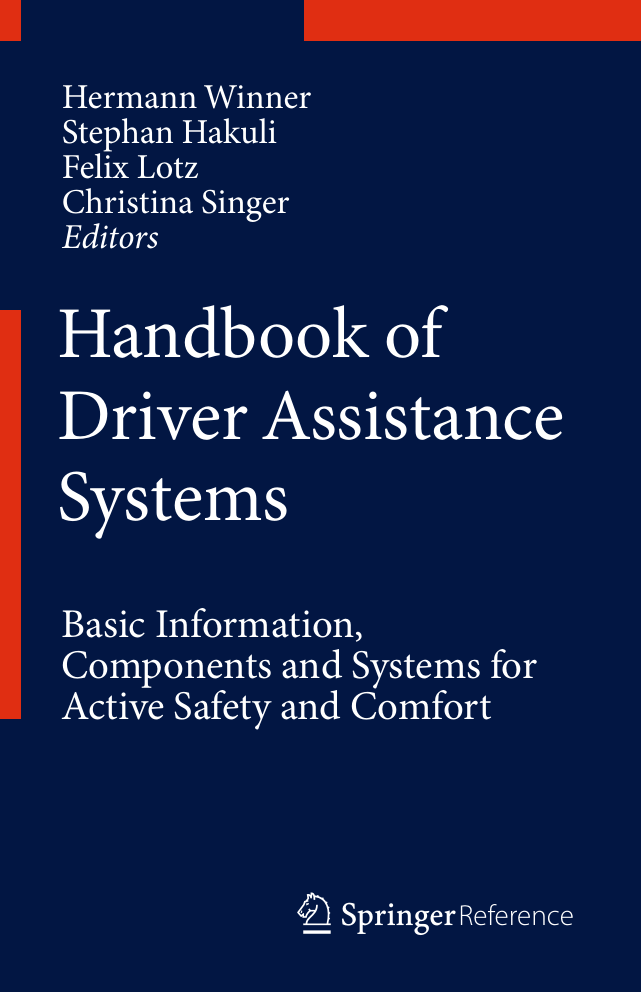
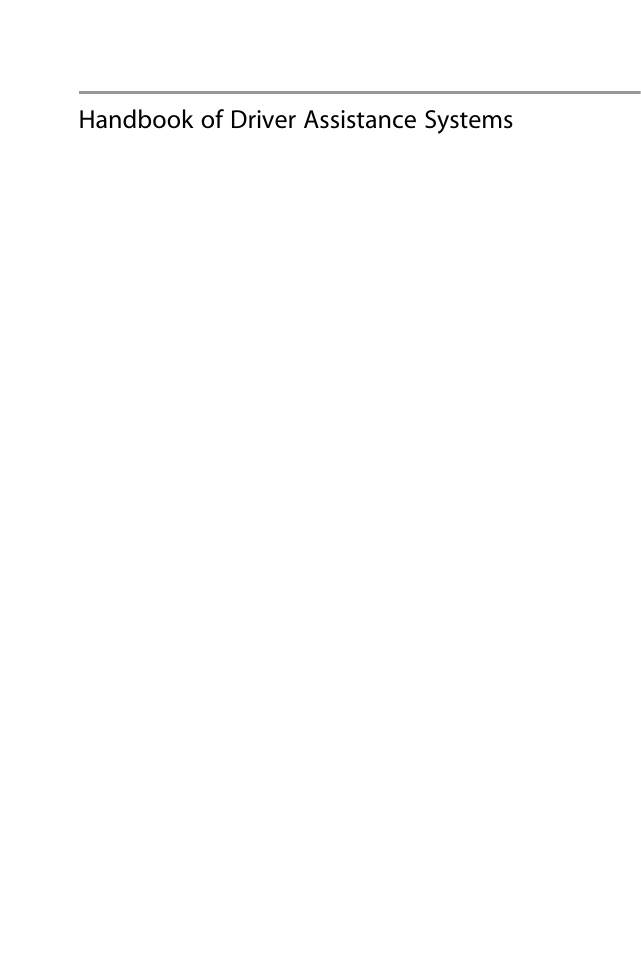

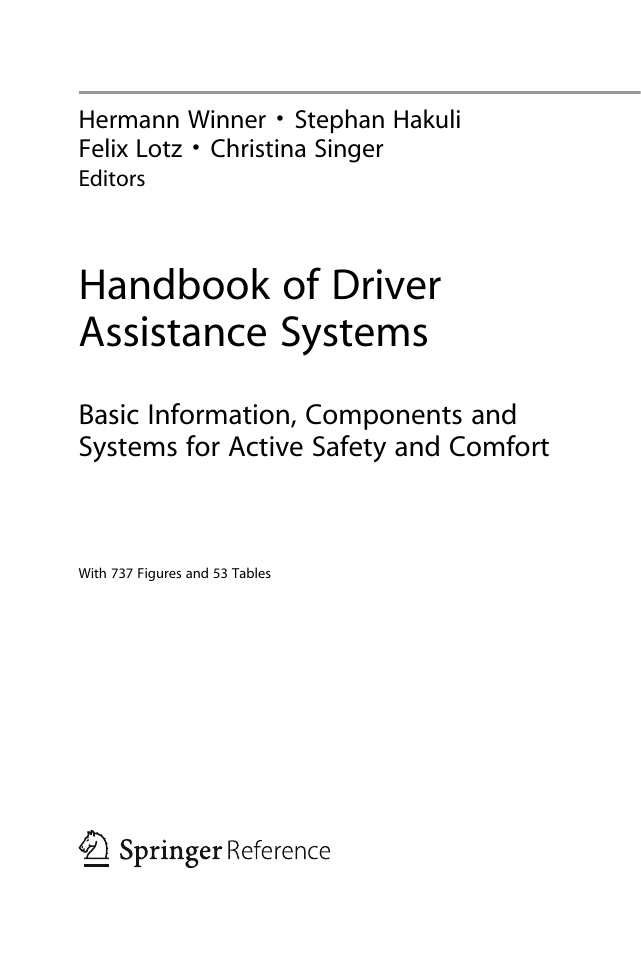
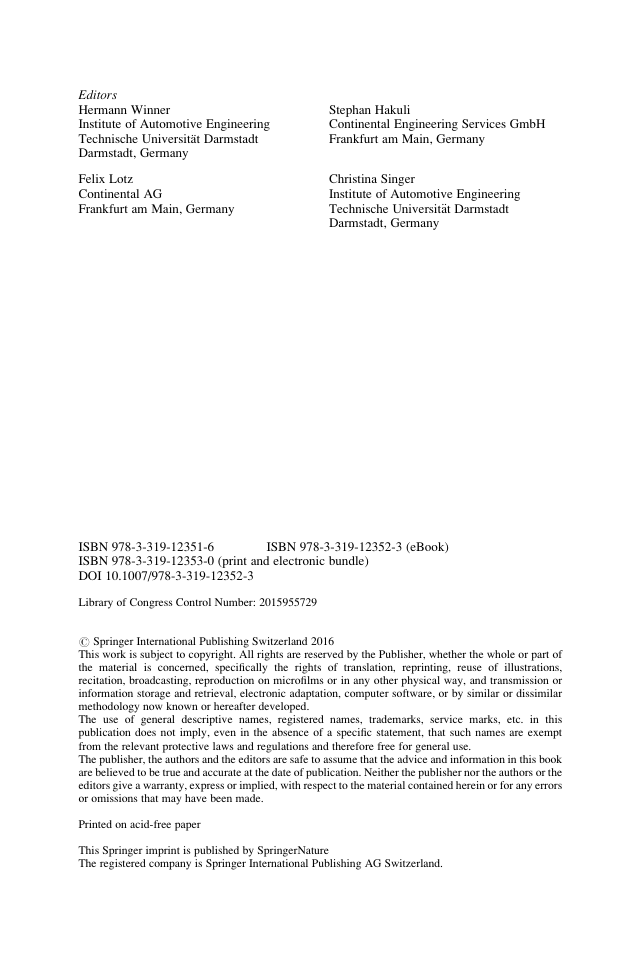
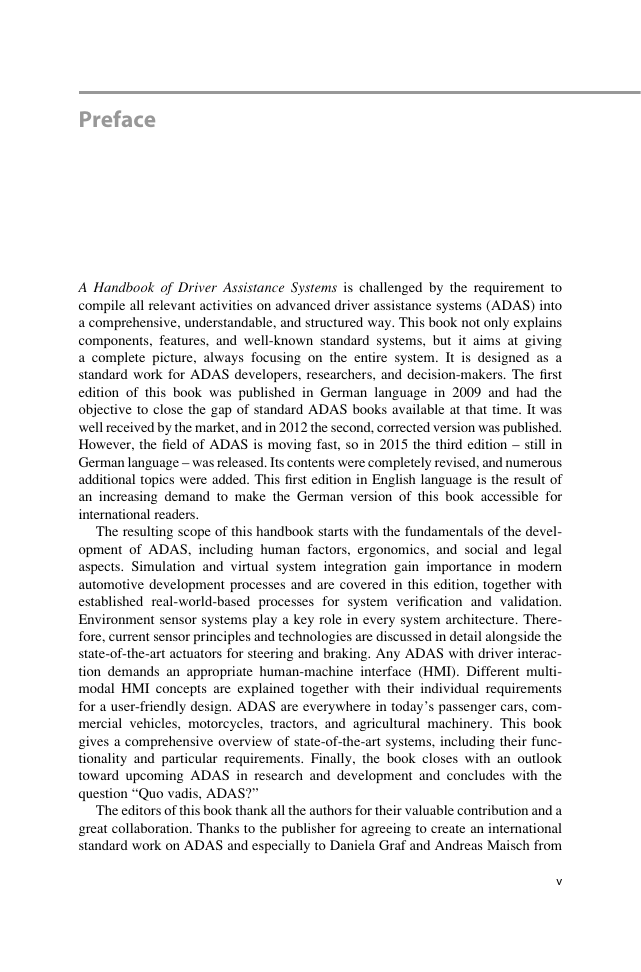










 2023年江西萍乡中考道德与法治真题及答案.doc
2023年江西萍乡中考道德与法治真题及答案.doc 2012年重庆南川中考生物真题及答案.doc
2012年重庆南川中考生物真题及答案.doc 2013年江西师范大学地理学综合及文艺理论基础考研真题.doc
2013年江西师范大学地理学综合及文艺理论基础考研真题.doc 2020年四川甘孜小升初语文真题及答案I卷.doc
2020年四川甘孜小升初语文真题及答案I卷.doc 2020年注册岩土工程师专业基础考试真题及答案.doc
2020年注册岩土工程师专业基础考试真题及答案.doc 2023-2024学年福建省厦门市九年级上学期数学月考试题及答案.doc
2023-2024学年福建省厦门市九年级上学期数学月考试题及答案.doc 2021-2022学年辽宁省沈阳市大东区九年级上学期语文期末试题及答案.doc
2021-2022学年辽宁省沈阳市大东区九年级上学期语文期末试题及答案.doc 2022-2023学年北京东城区初三第一学期物理期末试卷及答案.doc
2022-2023学年北京东城区初三第一学期物理期末试卷及答案.doc 2018上半年江西教师资格初中地理学科知识与教学能力真题及答案.doc
2018上半年江西教师资格初中地理学科知识与教学能力真题及答案.doc 2012年河北国家公务员申论考试真题及答案-省级.doc
2012年河北国家公务员申论考试真题及答案-省级.doc 2020-2021学年江苏省扬州市江都区邵樊片九年级上学期数学第一次质量检测试题及答案.doc
2020-2021学年江苏省扬州市江都区邵樊片九年级上学期数学第一次质量检测试题及答案.doc 2022下半年黑龙江教师资格证中学综合素质真题及答案.doc
2022下半年黑龙江教师资格证中学综合素质真题及答案.doc